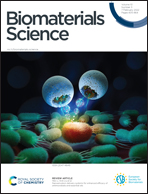Clodronate-nintedanib-loaded exosome–liposome hybridization enhances the liver fibrosis therapy by inhibiting Kupffer cell activity†
Abstract
Liver fibrosis therapy remains limited due to the inefficiency of drug delivery and inflammation induced by Kupffer cells. In this study, an exosome–liposome hybrid drug delivery system (LIEV) was developed to increase the efficacy of clodronate (CLD)-inhibition of Kupffer cells and to effectively deliver nintedanib (NIN) to liver fibroblasts to ensure enhanced anti-fibrosis therapy. CLD and NIN co-loaded LIEV (CLD/NIN@LIEV) exerted non-specific inhibition of phagocytosis by Kupffer cells, reduced inflammatory cytokines, and showed homologous homing properties mediated by fibroblast-derived exosomes, thereby achieving superior antifibrotic effects in a CCl4-induced fibrosis mouse model by inhibiting the proliferation of fibroblasts. Furthermore, the inhibited Kupffer cells regenerated within 10 days after dosage withdrawal. Unlike carrier-free NIN treatment, CLD/NIN@LIEV induced a marked decrease in liver enzymes, indicating improved safety and anti-fibrosis efficacy. These results indicate its great potential for treatment with the combined anti-fibrosis agent and Kupffer cell inhibition strategies to enhance the liver fibrosis therapy.



 Please wait while we load your content...
Please wait while we load your content...